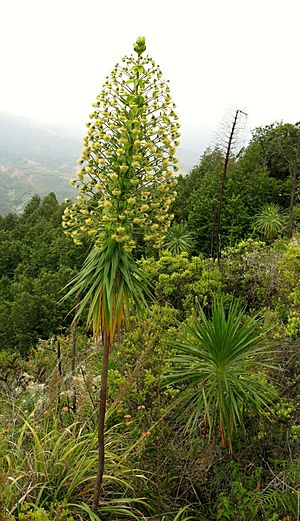Wilkesia gymnoxiphium facts for kids
Quick facts for kids Wilkesia gymnoxiphium |
|
|---|---|
 |
|
| Wilkesia gymnoxiphium growing near Waimea Canyon | |
| Conservation status | |
| Scientific classification | |
| Kingdom: | |
| (unranked): | |
| (unranked): | |
| (unranked): | |
| Order: | |
| Family: | |
| Genus: | |
| Species: |
W. gymnoxiphium
|
| Binomial name | |
| Wilkesia gymnoxiphium A.Gray, 1852
|
|
The Wilkesia gymnoxiphium plant, also known by its Hawaiian name iliau, is a special type of flowering plant. It belongs to the sunflower family, called Asteraceae. This plant is found only on the island of Kauaʻi in Hawaiʻi. When a plant is found only in one place, it is called endemic.
Sadly, the iliau plant is currently listed as an endangered species. This means there are not many of them left in the wild. The Wilkesia genus is part of a unique group of plants called the silversword alliance. This group includes other plants like the famous silverswords. Even though these plants look very different, they are all closely related. Scientists believe they all came from one type of plant that grew in North America.
What Does the Iliau Plant Look Like?
The iliau plant is a type of shrub that grows in a rosette shape. This means its leaves grow in a circular pattern, like a rose. The plant can grow quite tall, up to 5 m (16 ft) (about 16 feet) high, on a woody stem.
One interesting thing about the iliau is that it is a monocarpic plant. This means it flowers only once in its life, and then it dies. Its leaves grow in circles of 9 to 15 leaves, forming a base around the stem.
From May to July, the iliau plant produces beautiful yellow flowers that look like small daisies. These flowers grow in large clusters. If the plant's main stem is not broken, it will flower once and then die. However, if the top of the plant is broken, it might grow several new stems. Each of these new stems will then flower and die separately.
Where Does the Iliau Plant Live?
The iliau plant grows only on the island of Kauaʻi. It likes to live on dry ridges or in dry to moist forests. You can often find it growing along the slopes of Waimea Canyon.
These plants grow at elevations from 425–1,100 m (1,394–3,609 ft) (about 1,400 to 3,600 feet) above sea level. They need an average of 800–2,000 mm (31–79 in) (about 31 to 79 inches) of rain each year.
In the past, wild goats in the canyon would eat a lot of these plants. Because of this, iliau plants are now mostly seen on slopes that are hard for animals to reach. Luckily, there is a large group of iliau plants growing safely inside a fenced area. You can see this protected group just off the road that leads to Kōkeʻe State Park.


